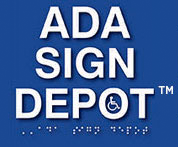529A Accounts Let Disabled Save Without Risk to Government Aid
ADA Sign Depot
May 10, 2016

529A Accounts Let Disabled Save Without Risk to Government Aid
{ Shop all Shop all Gender Neutral Bathroom Signs }
PEOPLE with disabilities will be able to open new, tax-free savings accounts under at least two programs offered nationally this summer.
The state-sponsored accounts are known as 529 ABLE, or 529A, accounts. Authorized in 2014 by the Achieving a Better Life Experience Act (ABLE Act), the accounts are modeled loosely on 529 college savings accounts.
The main benefit of the new accounts is that they allow disabled people to accumulate significant savings without jeopardizing their eligibility for need-based government help like Supplemental Security Income or Medicaid. Disabled people, their families and friends can contribute as much as $14,000 a year without putting federal benefits at risk.
Nebraska has announced that it will be among the first states to offer the accounts to a national audience, on June 30. Ohio has been testing enrollment in its accounts and expects to make the program available nationally this summer, but has not announced a firm date. Chris Berry, a spokesman for the Ohio state treasurer’s office, wrote by email that the program is “prioritizing doing it right over doing it quickly.”
Florida expects to start an ABLE program by July 1, but will restrict enrollment to state residents, according to the program’s website. Additional states are expected to begin offering the accounts later this year or next year. The National Down Syndrome Society tracks states’ progress on its website.
Nebraska, which calls its program Enable, will offer mutual fund investment accounts through Vanguard, and savings accounts insured by the Federal Deposit Insurance Corporation. Deborah Goodkin, the program manager for Enable, said it would offer several investment accounts, depending on a participant’s risk tolerance.
Families should consider any fees associated with the accounts when making a choice. The website for Ohio’s program, called Stable, for instance, says state residents will pay $2.50 a month to maintain an account, plus fees based on a percentage of their assets, depending on which type of investment they choose. Residents of other states will pay more.
Chip Gerhardt, a lobbyist in Ohio and a former chairman of the National Down Syndrome Society, said he considered the fees for the Stable program reasonable. “They’re below market,” he said.
Mr. Gerhardt, who has an 18-year-old-daughter with Down syndrome, worked for years to have the 529 ABLE law enacted, and said he has already established a Stable account for her under Ohio’s pilot program. He suggested that families that were uncertain about whether to wait until their own state offers an ABLE account consider opening an account in Ohio or another state that makes them available early. Then, they could transfer the account to their home state later to take advantage of possible benefits like a state tax deduction for contributions, he said. Since the accounts have annual contribution limits, starting early would help maximize the account’s earning potential, he said. “Why not start now?”
Advocates continue to work to enhance the accounts. Currently, for instance, ABLE accounts are available to those who became disabled before age 26. But In March, the sponsors of the original law proposed legislation to expand eligibility to those disabled before age 46. The ABLE Age Adjustment Act is pending in committee, according to Congress.gov.
Here are questions and answers about 529 ABLE accounts:
■ Where can I learn more about 529 ABLE accounts?
The Able National Resource Center has a www.ablenrc.org website with information about the accounts.
■ How does a 529 ABLE account differ from a special needs trust?
A special needs trust, also called a supplemental needs trust, can be used to shelter a disabled person’s assets, but can be expensive to establish and maintain. ABLE accounts are intended to offer a simpler, less costly option, advocates for the disabled said. But they have at least one possible drawback: Unlike funds in properly structured trust, funds remaining in an ABLE account may be tapped to help repay state Medicaid costs after a beneficiary’s death.
■ May I have more than one ABLE account?
No. Unlike 529 college savings accounts, you may have just one ABLE account.


